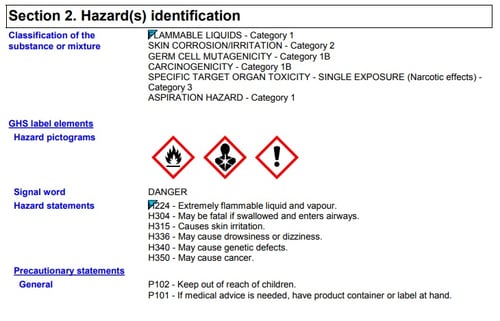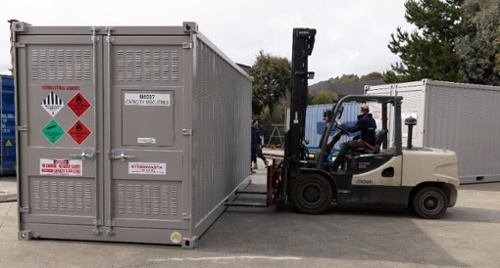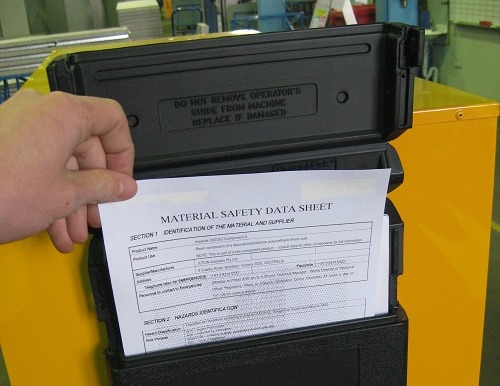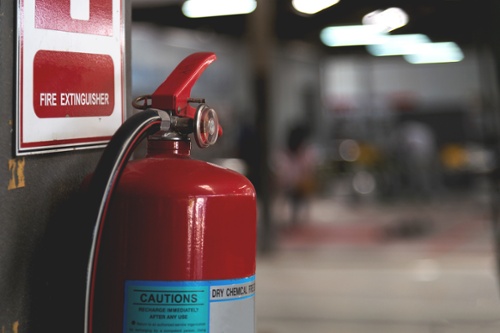When it comes to chemical safety, the first step in ensuring compliance is to have a thorough understanding of your hazardous substances, as well as the many hazards that they present. Your safety data sheet is a crucial document, which can help keep your workplace safe. Therefore, they should never be treated as 'boring paperwork' and left lying around in the supervisor's office or on the manufacturing floor. To properly control the risks in your organisation, it's important to get a solid understanding of the hazardous substances or mixtures that you're working with by consulting with your SDS.
So, What is a Safety Data Sheet (SDS)?
Your safety data sheet - otherwise known as a material safety data sheet (MSDS) or a product safety data sheet (PSDS) - is a document that details the hazards associated with your chemicals. This document contains essential information and requirements for the safe handling and storing of hazardous chemicals and dangerous goods in the workplace.
The Globally Harmonised System of Classification and Labelling of Chemicals (GHS) dictates the 16-section format of the safety data sheet. Within each of these sections is important information that is specific to the chemical that you have onsite.
REMEMBER: While two chemical products from different manufacturers may appear the same, you must never assume that your chemical has identical properties to a similar one.
What are the Employer's Legal Responsibilities for Safety Data Sheets?
Within the Model WHS Regulations, it states that every workplace must provide access to the safety data sheets to ensure the safety of their staff as well as the organisation and surrounding community.
As we know, hazardous chemicals and dangerous goods can cause harm to people, property and the environment - with incidents such as fire or chemical reactions also impacting nearby buildings, residences and public facilities.
A storage box is ideal for keeping your SDS within arm’s reach of each chemical store, as well as keeping the documents protected from damage.
How Do You Read Material Safety Data Sheets?
As a comprehensive document, safety data sheets are also quite easy to read and access due to the clearly marked sections set out in each document. Each section is vital for site safety, so it's a good idea to familiarise yourself with all elements of a safety data sheet - and train your staff to understand the hazard information and terminology.
Sections of a safety data sheet are as follows:
SECTION 1: IDENTIFICATION
This section will include the GHS product identifier, other means of identification (chemical type), the SDS number, historic SDS number, the product code, how the substance or mixture will be used, the manufacturer supplier and the emergency telephone number.
SECTION 2: HAZARD(S) IDENTIFICATION
You'll find the classification of the substance or mixture in this section, such as Flammable Liquids - Category 1 - and so on.
See the below SDS for an unleaded petrol:

The extensive information in Section 2 also includes:
- GHS label elements: hazard pictograms, signal word and hazard statements
- Precautionary statements: General, Prevention, Response, Storage, Disposal and supplemental label elements and hazards which don't result in classification.
SECTION 3: COMPOSITION AND INGREDIENT INFORMATION
Within this section of your material safety data sheets, you'll find the breakdown of ingredients, their concentration and their CAS number.
SECTION 4: FIRST AID MEASURES
One of the most important sections for your staff and first aid officers includes the necessary first aid measures that need to be taken when there is exposure to the chemical. Include these specifications in your first aid procedures and training.
SECTION 5: FIREFIGHTING MEASURES
Every workplace must be equipped with the correct type of extinguishers to successfully and safely put out a chemical fire. In addition to this information, you'll find other specific hazards that will arise if your chemical is involved in a fire. Include these instructions and safety precautions in your emergency planning and procedures.
Section 5 in your safety data sheets explains the necessary measures for fire control.
SECTION 6: ACCIDENTAL RELEASE MEASURES SECTION
Chemical leaks and spills can - and will - unfortunately occur. However, spills can create health effects on staff, environmental hazards, and affect the stability and reactivity of other substances. Your safety data sheet (SDS) includes personal precautions, protective equipment and emergency procedures for such a spill.
Your Spill Response Team should be fully aware of this crucial section, with information about hazards resulting from the spill, as well as the safe methods and material for containing and cleaning up the accidental release of chemicals.
To avoid chemical leaks and spills, make sure you have the correct bunding in place, such as bunded storage, bunded shelving, drum bunds, IBC bunds, floor bunding and portable bunds.
SECTION 7: HANDLING AND STORAGE
All personnel should be familiar with the handling and storage measures for the chemicals you have onsite. This includes provision for personal protective equipment, as well as storage and handling procedures and equipment that decreases the risks associated with your chemicals.
Hazardous physical and chemical properties of your substances will be controlled through the implementation of these safe handling and storage procedures. However, we also suggest an onsite risk assessment to help you properly prepare your worksite for the introduction of this new substance or mixture.

Your storage and handling requirements are detailed in Section 7 of your safety data sheets.
SECTION 8: EXPOSURE CONTROLS AND PERSONAL PROTECTION
To maintain a safe working environment, you must have a good air quality and the right personal protection. Section 8 of your safety data sheets is dedicated to explaining the exposure limits for the ingredients within your hazardous substances or mixture.
The chemical properties will affect the amount and type of vapours that the substance emits, with your SDS listing appropriate controls and protective measures to safeguard your workplace. See this section for advice on ventilation, engineering controls and personal protective measures.
SECTION 9: PHYSICAL AND CHEMICAL PROPERTIES
There are many properties that dictate the conditions in which a substance is used or stored. See this section for information about odour, pH level, melting and boiling point, the flash point of your hazardous chemicals and vapour density.
SECTION 10: STABILITY AND REACTIVITY SECTION
Chemical reactions can occur when incompatible substances, ignition sources or other hazardous conditions are present in a workplace. This section of your material safety data sheet will assist with your handling and storage procedures, allowing you to use your substances without risking reactivity hazards.
Like to learn more about chemical segregation?
SECTION 11: TOXICOLOGICAL INFORMATION
Hazardous chemicals can affect staff through inhalation, ingestion or contact with the body. This section of your sheet will give you specifics regarding to the chemical's irritants, corrosive properties, acute toxicity and other health hazards.
This detailed information also includes both short-term and long-term exposure to the substance.
SECTION 12: ECOLOGICAL INFORMATION
While we've discussed measures to protect the staff in your organisation, chemicals can also adversely affect the natural environment if they travel into soil, down drains or into waterways. The ecological hazards associated with your substances include the mobility of the substance as well as how dangerous it is when it reaches the soil.

Protecting the environment from your onsite chemicals is part of your ongoing WHS responsibilities.
SECTION 13: DISPOSAL CONSIDERATIONS INFORMATION
Leaks and spills will inevitably result in the disposal of soiled materials, unwanted chemicals and the resulting effluent. Your disposal considerations section is a great resource to assist with your development of compliant waste disposal procedures. Remember, never dispose of hazardous chemicals or affected items in your regular rubbish. These substances, including empty vessels which may contain residue or vapours, can still pose hazards after they have been put in the trash. So, follow the disposal considerations carefully.
SECTION 14: TRANSPORT INFORMATION
If you require transport information for your hazardous materials, then you'll need to refer to Section 14. This details the UN number, shipping name, transport hazard class (or classes) - as well as the packing group, environmental hazards and other essential information.
REMEMBER: This section is also important for determining the dangerous goods class for normal storage conditions.
SECTION 15: REGULATORY INFORMATION
This section offers regulatory information on your hazardous chemical that won't be found anywhere else in the document. This may include information relating to whether the substance is subject to international agreements. It will also detail regulatory information that applies to safety, health and environmental regulations.
SECTION 16: ANY OTHER RELEVANT INFORMATION
The last section of this document offers a key to abbreviations, as well as the details relevant to the safety data sheet including when it was printed, issued, revised and who prepared it.
We'll talk about the safety data sheet revisions a little later in the blog, as this will also impact how you maintain your safety data sheets in the workplace.
SDS Access
SDS information must be available for all staff and contractors that attend your site. This is so staff can quickly refer to the safety data sheets to remind themselves of the correct procedures to follow when handling and storing the hazardous substances.
The safety data sheets are also important in the event of an incident. Emergency responders, such as fire crews or ambulance officers, must be able to correctly identify the chemical, as well as understand the physical and chemical hazards that they present.
In the event of an accident, when chemicals are inhaled, ingested or make contact with the skin or eyes), first aid workers or ambulance officers must know the appropriate measures to take to reduce the impact of the hazardous incident.
Providing access to the safety data sheets is one of the key considerations to make when reviewing your chemical storage areas.

If you can’t locate your current SDS, then you can’t refer to them to ensure that you’re working safely with your substances.
Failure to do so can impede your site safety, first aid measures and emergency procedures, as well as put you at risk of non-compliance.
REMEMBER: There is no time to be wasted when there is a workplace accident or emergency. Never leave safety data sheets in an office drawer or laying around the worksite in an unmarked location. We highly recommend using a waterproof document holder to keep your SDS close to each hazardous chemical store.
Keeping a Current SDS
As we touched on earlier in this post, Section 16 of your SDS explains when the document was created and printed. It's important to remember that SDS become redundant after a period of time, so they must be replaced with the updated version.
Safe Work Australia advises that SDS manufacturers and importers of hazardous chemicals need to review and update these documents every 5 years. Therefore, it’s important that your workplace develops procedures to enable you to action these data sheet updates. This will help you maintain compliance and safety by always having the current version at your site.
Safer Workplaces with SDS Storage
To learn more about creating a safer and more compliant workplace, why not access our eBook? The Ultimate DG Storage Handbook highlights key points to consider when keeping hazardous substances and dangerous goods in the workplace. We even discuss the importance of keeping your SDS close to your safety cabinets and other chemical storage facilities. Get your copy today to find out more.
Joining the team as a Dangerous Goods Storage Consultant, Melissa Hampton became Storemasta's Marketing Manager in late 2021. With extensive knowledge and experience in chemical compliance, Melissa is responsible for leading the Marketing team and helping shape their marketing strategy. In her spare time, you can find Melissa hiking, swimming and enjoying the great outdoors in beautiful north-west Tasmania.


